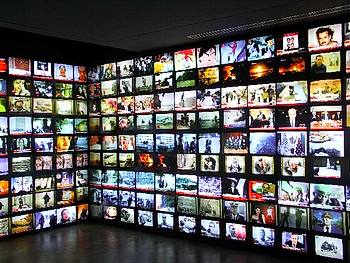The Age of the Image. Simulated Realities. “The Image-oriented way of Viewing the World” ~ hehe "we" r b'ing...have been & r gonna STILL B , fucking played...until "we" wakey wakey, eggs & bakey lil peeps Oops
JOE JACKSON ★ Is She Really Going Out with Him 【HD】

In the movie The Truman Show,
the main character is locked into a world of image: he is the unknowing
star of a “simulated/constructed reality” television show, whose life
is tightly controlled by those seeking to project the TV images they
want beamed to the world, showing the day-to-day events in Truman’s
life. In the world of social media today, we are voluntarily becoming
just like Truman: involved in a world of controlled images, and
concerned with truth very late in the game, if at all.
This image-oriented way of
viewing the world has significant consequences. For example, last year
the Pew Research Center reported nearly a quarter of American adults had
not read a single book in the past year. The number of non-book-readers
has nearly tripled since 1978, when 13 percent responded that they had
read more than 50 books in a year. Today, Pew finds that just 28 percent
hit the 11 mark. Last year, the NEA found that 52 percent of 18-24
year-olds had not read a book outside of work or school. (The Atlantic, January, 2014).
There are two uses of media
technology today that reinforce this trend, and both have to do with
the actual production of images. The first use is the oft-discussed
practice of government and media in crafting images of propaganda for
public consumption. In this practice, both the word and the visual image
are geared to get the public at large to believe in something and to
react to that created—and often false, incomplete, or misleading—image.
The other use of media
technology is less discussed, and that is the use of technology by
individuals to create an image of reality, including an image of
oneself, that is intended only for the sensory consumption of others,
but is actually only an expression of our desired public—and often
false, incomplete, or misleading—image how we would like people to see
us. So whether the use of technology is by government or by individuals
on social media, crafting and consuming primarily images instead of
attempting to understand the reality behind the images seems to be the
fate of Western culture, and the challenge to those attempting to change
society for the better.
 To
be specific, by “images,” I mean the use of visualizations, sounds,
words, and/or actions, done either in personal encounters or via modern
technology, that are intended to produce a pre-ordained visceral effect
in or to some other person or persons. The heavy reliance on
image-creation, whether by government, media, or individuals, makes
people quite vulnerable to manipulation, if they don’t ask questions,
and if truth becomes just a function of the image-created.
To
be specific, by “images,” I mean the use of visualizations, sounds,
words, and/or actions, done either in personal encounters or via modern
technology, that are intended to produce a pre-ordained visceral effect
in or to some other person or persons. The heavy reliance on
image-creation, whether by government, media, or individuals, makes
people quite vulnerable to manipulation, if they don’t ask questions,
and if truth becomes just a function of the image-created.
On the level of
institutional image-creation, this can be easily seen by each attempt
the U.S. makes to paint an image of “the latest enemy” as “a threat to
national security” or “a terrorist threat.” Thus, from the Taliban to
Saddam Hussein to Isis and beyond, the image portrayed is not confirmed
by the facts. Isis is not a threat to U.S. domestic security, only to
U.S. Mideast interests. Such images can even become downright humorous
when one actually takes time to analyze the image-creation
attempted, such as when Benjamin Netanyahu went before the United
Nations and presented a speech centered on a cartoonish drawing of an
old-fashioned fuse bomb, whose fuse was lit and which would explode when
the Palestinians were granted their human and political rights.
On the individual level,
the sense of self that is created by the image is ironically entirely
self-defeating because in the process of projecting a desired image of
our self, our self then becomes who the other sees us to be; the sense
we get of ourselves from the other who participates in our own
technologically-created fantasy. This is postmodern ideology come home
to roost: rejecting a sense of self that comes from introspection, from
within, through self-reflective, self-conscious understanding,
integrity, and digging for the truth, and embracing instead an
externally-determined self as a function of one’s social and public
persona. This is often summarized by the number of “Facebook Friends”
one has. When we live for and in a world of images, both the world and
our self are then false and hollow. Both are directly opposite the
self-expression of an authentic self: a self that is based on an already
present and abiding internal knowledge of one’s worth, dignity,
integrity, and self-confidence.
 So-called
“smart phones” and corporate and government media propaganda are thus
all contributing factors to “the age of the image:” they are propaganda
mechanisms used to craft images, and lost is the recognition that truth
and reality lag behind images, since they take longer to assimilate.
This is because the rational mind—that dynamic of our cognition which
seeks truths and sorts facts from fiction—requires reflection time in
order to assimilate its contents. Using images requires no reflection
and little time: knowledge is visceral; facts are in the present;
reflection is “yesterday.”
So-called
“smart phones” and corporate and government media propaganda are thus
all contributing factors to “the age of the image:” they are propaganda
mechanisms used to craft images, and lost is the recognition that truth
and reality lag behind images, since they take longer to assimilate.
This is because the rational mind—that dynamic of our cognition which
seeks truths and sorts facts from fiction—requires reflection time in
order to assimilate its contents. Using images requires no reflection
and little time: knowledge is visceral; facts are in the present;
reflection is “yesterday.”
The social consequences of practicing and living in an image-based hyper-reality are stark.
First, no holds are barred
for the goal of producing the desired image. Truth is relative and slave
to the image; knowledge is opinion; and no one counts as a distinctly
human end in themselves. Rather, everyone is susceptible to being
reduced to a means, a role-player in and of a world of images. In other
words, if I’m concerned only or primarily with how you see me, I’m not
concerned with you as a person. The ethical implication is this: I can’t
have compassion for an image; I can only have compassion for a
flesh-and-blood human being. In hyper-reality, there is no such depth.
This happens on a personal and governmental level.
 The
clearest example of this on the governmental level is the way drone
controllers in the U.S. operate the drones that fly half a world away in
Pakistan and Afghanistan. As most people now know, the drones in
Afghanistan and Pakistan are controlled from the state of Nevada. What
most commentators do not comment on is how the image that the drone
pilots watch controls their very mental processes. The images they see
are not of humans, but of what they term “sightings.” The actions based
on perceiving these images in this distinct way is entirely different.
If one sees a human being, one is reluctant to kill them when they do
not know what that human is doing. However, responding to the image as simply a “sighting,” the entire point of action in response to the “sighting” then becomes only to “target”
the “sighting.” In fact, drone operators can’t even make out faces;
only little pixels that look like video game targets. Thus, using images
alone changes the way we take in the world, such that the military
personnel who fire the drone missiles don’t even see a human. The image
of “sightings” becomes the image of “targets,” and the “proper” action
then becomes “click-and-kill.”
The
clearest example of this on the governmental level is the way drone
controllers in the U.S. operate the drones that fly half a world away in
Pakistan and Afghanistan. As most people now know, the drones in
Afghanistan and Pakistan are controlled from the state of Nevada. What
most commentators do not comment on is how the image that the drone
pilots watch controls their very mental processes. The images they see
are not of humans, but of what they term “sightings.” The actions based
on perceiving these images in this distinct way is entirely different.
If one sees a human being, one is reluctant to kill them when they do
not know what that human is doing. However, responding to the image as simply a “sighting,” the entire point of action in response to the “sighting” then becomes only to “target”
the “sighting.” In fact, drone operators can’t even make out faces;
only little pixels that look like video game targets. Thus, using images
alone changes the way we take in the world, such that the military
personnel who fire the drone missiles don’t even see a human. The image
of “sightings” becomes the image of “targets,” and the “proper” action
then becomes “click-and-kill.”
Even in media reporting of
conflicts, it is the sensational image that makes the story, not the
details of the story itself. The traditional media motto, “if it bleeds,
it leads,” has become “if it titillates the vision, it doesn’t matter
the precision.”
The second social
consequence of living in a world of images is that our view of reality
changes: nothing is substantively real; everything is a technological
art, an electronic reality. In such a “cell phone society,” the
authentic self, and its understanding of being completely immersed in
the spatiotemporal world, the physical and temporal now, is
substantially diminished. The real self includes the ability to examine
the inner experience of being human, and discussing that with others, in
person, all of which results in meaning, which requires self-reflection
and thought about self and world and society, not just visceral
impressions. Absorption in creating or responding to crafted personal
and/or multi-media images directs us to sheer immediacy: one cannot be
concerned with the truth when the idea of what is true goes no further
than the image, be it given or created.
Third, there are issues
concerning what a technologically-created image does (or doesn’t) do to
the mind/brain. We have the clear potential to be rational thinkers. But
when people reduce themselves to the production, combining, and
manipulation of images and call it “thinking” or “understanding,” they
remain at the lowest levels of human cognition, with very little
authentic self-consciousness. More specifically, thinking is reduced to
mental processing by and through images rather than through facts and
concepts and their relation. The latter is more rational and fine-tuned
than the former, and has for many centuries been held to be an integral
part of human nature. Regular empirical studies are published that
demonstrate the lethal combination of a high amount of technology use
and reduced cognitive functioning (see, for one good example, the study
published in mid-2014 by The Atlantic).
The implications of this
change to the mind/brain are significant. One is that thinking through
what counts as evidence to a given claim is gone in an image-based
world; it just takes too long to do that, when the image says everything
for someone who believes in it. The point here is not that images don’t
or shouldn’t count as evidence. Rather, the point is that while use of
images can be a good in itself (e.g. police abuse of African Americans
in the U.S., etc.), when they are used as the first, foremost, and/or
definitive assumption as to what counts as evidence in forensics and specifically
in thinking about and discussing social issues, it reduces the ability
of people to compile factual evidence and draw conclusions in a
specifically rational-logical way. The image does the thinking for me.
This is what the philosopher Jacques Ellul refers to when he coins the
phrase “the triumph of the image.”
If this is all true, why
don’t we or can’t we just put our cell phones down for a day and/or shut
off the TV? The answer is that we are already fully immersed in an age
in which we live our lives through and in the images created by and for
us: we are psychological junkies for new and mesmerizing—and most of
all, superficial—images, by which we experience our thrills, agonies,
consolations, and even relaxation. Most of all, the images tell us our
“reality,” and thus what to believe and how to “think,” so that we no
longer have to do it for ourselves. Such is the age of the image, that
we are so addicted to living in it, and creating our images for others,
that shutting it all off would put us in a whole different world, and
thus a whole different mindset, in which “reality” and “truth” would
strike us right between the eyes: our comfort and the phony world of the
image we have created and live in would be shattered, gone, and in its
place would come discomfort, the unease of being alive in the world, the
difficult process of thinking about events, of actively assimilating
facts, issues, and evidence, and of forming and understanding our “self”
before broadcasting a simple image to the world. Most of all, truth, or
a concern for truth, would replace image. We would be more prone to
look at the hard truths of climate change and global inequities; of the
harshness of war, and the dysfunction of a society that values money,
possessions, and ego over authentic human connections. We would have to
face the fact that a “Facebook friend” is not a real friend, who shares
our “real space.” We would have to experience our sorrows and find our
joys in the consort with others, and in nature, and they would all
engage us at a deeper, more human level than merely having images of
persons, events, and issues, because they would require our full
presence, not our half-presence/distracted presence, as technological
images do. The latter take no effort, no concentration; the former do.
In The Truman Show,
Truman chooses to leave the world of the image for a most uncertain and
definitely less easy life. But he realizes that at least he would then
be able to create the life he chose to live, with all its complexities,
ambiguities, and uncertainties, instead of living in the predictable,
tightly controlled and manipulated world of the image he was used to and
eventually came to know as an image.
In real life, we face the
same issue as Truman did, but most people who are immersed in the
image-based tech world of social media don’t see it. This issue is this:
will we continue to craft and live in the artificially-induced, unreal,
untrue, and phony world of the image that government, media elites, and
tech-friends all encourage for us, or will we regain that human
authenticity that is thoughtful, reasonable, reasoning, and oriented
toward truth and reality? The former road is the world of the automaton,
the world of the faux human. The latter road is the human road. It’s a
tougher road because it is real, and requires our focus, but it is also
the most distinctly humanly-fulfilling world. Fascists rule by image;
democracy requires face-to-face dialogue with others about what is true,
right, and just. We are at a crossroads in our democracy: be Trumans or
be Jeffersons? The choice is ours, individually and collectively.
Dr. Robert Abele
holds a Ph.D. in Philosophy from Marquette University and M.A. degrees
in Theology and Divinity. He is a professor of philosophy at Diablo
Valley College, in California in the San Francisco Bay area. He is the
author of four books, including A User’s Guide to the USA PATRIOT Act,
and The Anatomy of a Deception: A Logical and Ethical Analysis of the
Decision to Invade Iraq, along with numerous articles. His new book,
Rationality and Justice, is forthcoming (2016).
Copyright © Dr. Robert P. Abele, Global Research, 2015



No comments:
Post a Comment